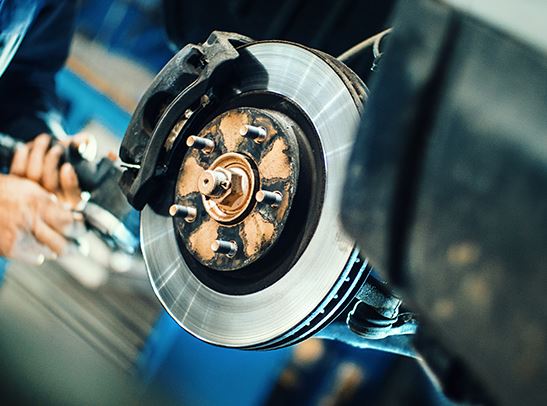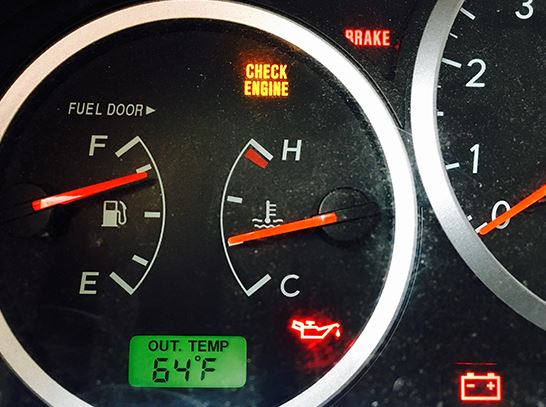What’s Antilock Brakes in a Car?
ABS stands for Antilock Braking System. ABS keeps brakes from locking up, providing better control while braking.
 by Brad Nelson|January 27, 2022
by Brad Nelson|January 27, 2022
ABS stands for Antilock Braking System. ABS brakes do what the name implies – they keep your brakes from locking up while braking. Why? Because once tires start to skid, vehicle control is lost. Therefore, ABS brakes can help you to maintain more control of your vehicle, particularly while braking and turning or swerving at the same time. In normal driving conditions, ABS systems can also help you stop in a shorter distance. In this post, we’ll answer the question: what’s ABS in a car?
There are four proven benefits of ABS:
- Cars fitted with ABS are less likely to be involved in a fatal crash.
- ABS decreases the chance of front-end collision on wet and dry roads.
- Cars with ABS maintain more control while braking – especially through turns, swerves or in variable conditions.
- During an emergency stop, a car with ABS tends to stop in a shorter distance than a vehicle without ABS.

If your ABS light stays on, something isn’t working in the system. Make the safe choice to have a technician fix the problem immediately.
How Do ABS Brakes Work?
ABS uses sensors attached to each wheel that detect if a wheel is not turning, which tells the system the wheel is starting to lock up. When that happens, a modulator slightly releases the brake pad on that wheel, allowing it to continue rolling.
Modern ABS systems are linked to the vehicle’s onboard computer and have become increasingly sophisticated and effective. These systems don’t just prevent wheels from locking up during braking, they also alter the front-to-rear brake bias and can prevent problems such as oversteer or understeer. Depending on specific capabilities, this latter system is known as electronic brake distribution, traction control system, emergency brake assist or electronic stability control (ESC).

Do ABS Brakes Improve Safety?
Intuitively, locking up your brakes might seem like the best way to stop quickly. But it turns out, that’s not how the physics work.
This is true on all surfaces, but especially on slick roads.
Second, a wheel can only turn a car if it’s rolling. Once the tires begin to skid, the vehicle will continue to travel in a straight line regardless of how the wheels are turned. This is a recipe for an accident, especially when a driver needs to swerve to avoid another vehicle or object. If the tires continue to roll, the driver can keep maneuvering the vehicle, even while braking hard.
ABS brake systems can also be a huge safety feature on roads with variable conditions. For example, if you’re driving on a road with patches of black ice and you apply the brakes, tires touching dry pavement may grip while tires on ice may begin to slide. This can create a yaw torque throughout the entire vehicle that can put you into a spin.
Modern ABS with electronic stability control will help immensely in this scenario. With ESC, the yaw rate of the car and relative slip of each wheel is measured. Adjustments are made by reducing brake pressure slightly on wheels that have the most grip to reduce yaw torque and maintain vehicle control.
Instead, much like a sled, friction between the tires and the road is reduced once the tires begin to slide. Therefore, tires hold the road best when they are rolling.
How Effective Are Antilock Brakes?
ABS brakes are highly effective, but they do have some limitations. In fact, a highly skilled driver can outperform ABS in some driving conditions, such as loose gravel or snow.
That’s because with ABS the brakes are rapidly engaging and disengaging. On very soft or slippery surfaces, the tires simply go from sliding, to rolling, to sliding and back again. Therefore, a driver who practices threshold braking, applying the brakes as much as possible without allowing the tires to slide, can outperform ABS in these conditions. However, threshold braking takes practice and feel to achieve, especially in a panic situation.
And when you’re driving in winter, always allow yourself a lot of extra time to stop.
It’s worth noting, even on snowy or icy roads, ABS will still drastically improve control while braking hard.
You can work around most ABS shortcomings by following a simple rule: the softer the surface, the softer you brake. Brake hard on pavement, brake gently on snow or ice.
How Do I Know if My Car Has ABS?
ABS has been a standard feature since 2012, so you probably have it. You can check by looking for an ABS light at startup in the gauge cluster. The ABS light will come on while the system is checked and then turn off. If you don’t see it there, you can always check your owner’s manual to make sure.

What if My ABS Light Stays On?
The ABS light should come on briefly when you start your car, then turn off. If the light stays on, that means something isn’t working in the system. Common ABS problems include low brake fluid and ABS or ECU sensors.
If you’re driving when the light comes on you can continue to your destination with caution. However, the problem should be tackled immediately. It’s the safe choice and some insurance policies will deny accident payouts if they establish the ABS system was down at the time of an accident.
If the brake-warning light also comes on, don’t risk losing your brakes completely. Stop immediately and call for roadside assistance.
ABS History
Like all technologies, ABS brakes have become more sophisticated and effective over time. Interestingly, the concept for ABS brakes has been around for more than a century. Here is a brief timeline of their development.
1908: J.E. Francis invents a “Slip Prevention Regulator for Rail Vehicles.”
1920: French automobile and aviation pioneer Gabriel Voisin experiments with systems to modulate hydraulic braking pressure on his aircraft brakes.
1958: Road Research Laboratory tests the Maxaret anti-lock brake system on the Royal Enfield Super Meteor motorcycle. Although stopping distances were reduced in most tests, it was not put into production.
1966: Jensen Motors releases the Jensen FF, the world’s first car with a fully mechanical ABS system and all-wheel drive. Shortly after, Ford introduces an experimental Zodiac with mechanical ABS, but the system proved too expensive and ineffective for production.
1969: A fully electronic anti-lock braking system is developed for the Concorde airplane.
1971: Mario Palazzetti of the Fiat Research Center develops “Antiskid,” the first modern ABS system for automobiles. The patent was sold to Bosch who renamed it ABS.
1970s: ABS remains an uncommon feature for most mass-market cars. Robert Bosch acquires patents and begins a joint development venture with Mercedes-Benz. Many of the era’s advancements debuted on Mercedes-Benz cars.
1980s: BMW leads ABS development for motorcycles like the K100.
2012: Electronic stability control, which includes ABS and traction control, are required on all vehicles.
So, What’s ABS in a Car?
ABS keeps your brakes from locking up while braking. In so doing, the system decreases the number of fatal crashes and front-end collisions on wet and dry roads. Cars with ABS maintain more control while braking, especially through turns, swerves or on variable conditions. And, especially during a panicked situation, ABS usually helps drivers stop in a shorter distance. ABS is a vehicle technology that makes us all safer on the roads, and we can all be grateful for that.
What’s the difference between DOT 3 and DOT 4 brake fluid? This post lays it out.
DOT 3 and DOT 4 Brake Fluid: What’s the Difference? – AMSOIL Blog
Want to change your own brake fluid? This post tells you how.
How to Bleed Brakes – AMSOIL Blog

